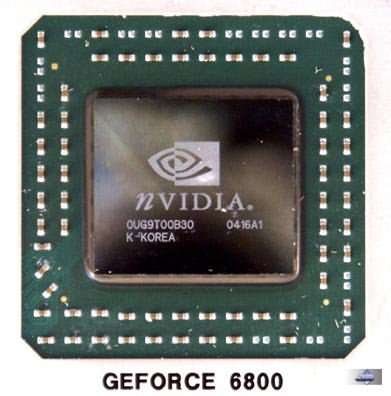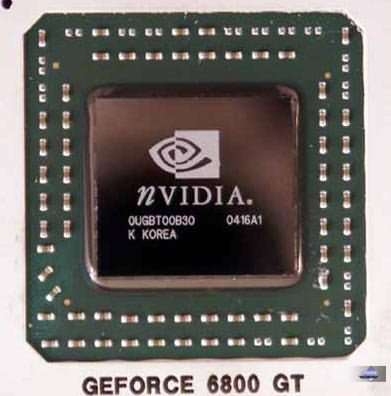 |
||
|
||
| ||
CONTENTS
NVIDIA prepared new accelerators this spring and has been showing them at various exhibitions, seminars, and conferences since that time, while ordinary users had to wait till they became available. And finally, first serial cards appeared, at least on Western markets. Today we're testing two boards based on similar chips. Well, in fact the chip is the same, but... you better read the following articles and you'll see how variable NV40 can be.
Theoretical materials and videocard reviews concerning
Well, 6800 Ultra and 6800 are based on one and the same chip, the only difference being that the latter has lowered frequencies and 1/4 of pixel pipelines disabled. So, cards based on them will look similarly. Now let's speak a little about the manufacturing company. It is hardly a secret that Leadtek Research is one of the leading brands in graphic card production, and its goods are highly respected in Russia. Unfortunately, because the recent years saw a rise in Leadtek cards' popularity, vendors started to overprice the company's products, to the extent that sometimes its cards cost even higher than ASUSTeK's. And that had a bad influence on Leadteck's popularity in Russia. But luckily, the situation changed for the better during last year, and now Russian customers can buy Leadtek products cheaper than its rivals' (such as MSI and the like). What is so good about Leadtek and its production? First of all, you can be sure about the quality. Indeed, Leadtek products have always had fewer claims than those made by any other company, that is why we have been recommending the company's cards to our readers for quite a while. As for the design and its originality, the opinion is divided here. Some solutions were rather ambiguous and we even criticised this or that design. But luckily for users, the situation have changed greatly of late and much-heat-emitting graphic cards are no longer covered with shells that make it even hotter for them. Now let's look at the cards. Boards
What can we see? First, 6800 Ultra is fully based on the reference design, as was expected. Second, GeForce 6800 design is close to 6800 Ultra, although there are some significant differences, especialy concerning the PSU as the card contents with one power connector. Third, both cards have memory chips only on their front sides, while the back ones feature no sockets for additional chips and are therefore not made for such purposes. But note that the company's engineers installed a large copper heatsink onto the card's back side. What did they do it for?
The answer is quite simple. Almost the whole memory is cooled via its pins in the BGA package, that is, the heat moves into the card, the PCB. If the engineers installed heatsinks on chip covers, it wouldn't have the effect it has in the TSOP package. Considering all this, the solution to install a heatsink onto the back side looks very sensible. Especially because it is firmly pressed to the PCB via soft heat-conducting elements which protect fragile logic elements (on the back side of the PCB) and level the PCB relief shape created by the same element base.
Nowadays NVIDIA puts its marking on the frame in all serial cards, while the die only contains the logo and the date of production. So we can see the following thing above the cooler:

Now let's look at the same chip from GeForce 6800 GT (the GPUs have different numbers of working pipelines). 
Obviously, only the on-die markings are different. We don't know for now if they contain information on the number of enabled pipelines or the chip name is immediately stuck to the cover during the check of broken pipelines, and the marking is put on the die afterwards (NVIDIA employees definitely have to know which chip they're dealing with). Having coped my long-lingering doubts, I once decided to supply GeForce 6800 with a GeForce 6800 Ultra BIOS. It is generally possible as, in contrast to ATI, NVIDIA does not set strict parameters of memory timings and size in BIOS. During the experiment, GeForce 6800-to-Ultra memory size was read correctly (128MB), but the frequency couldn't be fixed at 700, and the display showed garbage (indicative of overstated frequencies). Through it, I could see Windows identify the card as Ultra, but as it was impossible to work, I reinstalled the right BIOS. All the frequencies have restored and the card works all right, but... there is just one but. Some tests started to show artefacts in the form of broken lines, which clearly meant something was wrong with the card. What was the most puzzling is that it only revealed in some tests. Such complex ones as FarCry, TRAoD, etc. run perfectly, but Splinter Cell and RtCW had these artefacts followed by a total hang. The answer came when I looked at the results of the tests that worked. Performance increased compared to the original GeForce 6800! The fillrate test (3DMark03) showed that the number of pipelines remained 16! That is, 6800 BIOS hadn't brought the 12-pipeline state back! The reason for this lies probably in 6800 Ultra BIOS which can reprogram certain elements (chip registers, for example) and which obviously changed the number of pipelines. 6800 BIOS can do none of that, so the number of pipelines remained the same. Probably, it just checks the number in such a way that if it is not smaller than the necessary one (12), than BIOS changes nothing. So, the question remains open and perhaps, our ubiquitous Alexey Nikolaichuk will find out the reason and work it all out. I managed to find an answer why such complex things as FarCry do not damage the card while old ones can't work. Those four pipelines that were disabled and that I enabled are just partially, not completely broken. Perhaps, it affected some parts (like texturing caches) which are not used by FarCry, while all shader units remained workable. But we're leaving this issue for the moment and will be waiting for new information on this account to appear. Now let's take a look at the bundle. And now the box itself. As for overclocking, we did it with both cards, and they both revealed a good potential (see diagrams below). Unfortunately, the drivers clearly hindered their full overclocking, and it was impossible to reach really maximal frequencies (here again, we set our hopes on Alexey Nikolaichuk).
At nominal frequencies, maximal heating was 72°C with no additional cooling:

Setup and driversTestbed configurations:
VSync is off.
[ Next part (2) ]01.07.2004
Write a comment below. No registration needed!
|
Platform · Video · Multimedia · Mobile · Other || About us & Privacy policy · Twitter · Facebook Copyright © Byrds Research & Publishing, Ltd., 1997–2011. All rights reserved. | |||||||||||||||||||||||||||||||||||||||||||||||||||||||||||||||||||